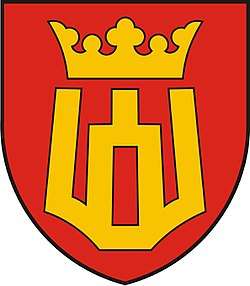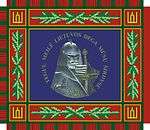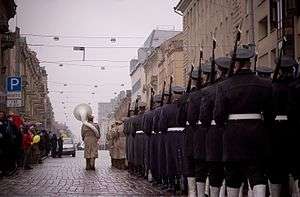Grand Duke Gediminas Staff Battalion
The Grand Duke Gediminas Staff Battalion (Lithuanian:Didžiojo Kunigaikščio Gedimino pulkas) is a unit of the Lithuanian Armed Forces, providing guard of honour units and HQ security on its behalf. It is located on 14 Jonas Kairiūkštis Sreet, in Vilnius.[2] 25 August is considered the Day of the battalion.
| Grand Duke Gediminas Staff Battalion | |
|---|---|
| Didžiojo Kunigaikščio Gedimino pulkas | |
 Insignia of the Battalion | |
| Active | September 8, 1998 - Present |
| Country | |
| Allegiance | Lithuania |
| Branch | Lithuanian Armed Forces |
| Type |
|
| Part of | |
| Garrison/HQ | Vilnius |
| Anniversaries | 25 August (Day of the Lithuanian Grand Duke Gediminas Staff Battalion) 28 November (Day of the Honour Guard) |
| Commanders | |
| Commander | Lieutenant Colonel Egidijus Čiūtas |
| Chief of Staff | Major Vytautas Gudas |
| Notable commanders | Lieutenant Colonel Saulius Juškevičius Juozas Kačergius[1] |
| Insignia | |
| Identification symbol |  |
History
It was founded on 23 November 1918 by order of the Minister of National Defence as the 1st Infantry Regiment. The Regiment was deactivated after the Red Army invaded Lithuania in 1940. In 1993, the Separate Commandant Battalion became the successor of the regiment. In 1997 veterans of the regiment asked President Algirdas Brazauskas to rename the regiment after the Gediminas. On 8 September 1998, the Separate Commandant Battalion was renamed to the Grand Duke Gediminas Staff Battalion by order of the Minister Česlovas Stankevičius.[3][4]
Composition
- Honour Guard Company
- Military Band
- Provision Company
- Signal Company
- Communication and Information Systems
- Intelligence Support Centre
Honour guard company and its public duties
Today, the 98 soldiers and officers coming three branches of the armed forces (Land Force, Air Force, and Naval Force) use American M14 rifles. Over the quarter century since the founding of the unit, more than 3,500 Lithuanian citizens have served in it and has taken part in more than 5700 ceremonies and reconstructions. The uniform of the company is based on the examples from of the interwar period. During demonstrations, the soldiers of the historical platoon put on the armor of the soldiers of the 14th century Grand Duchy of Lithuania. It celebrated its silver jubilee in November 2016, during which a ceremonial parade of the unit was held on Daucanto Square near the Presidential Palace, attended by President Daukanto Square.[5] Grybauskaite personally greeted the soldiers and said: "These soldiers are the mirror of our army. Each of them evokes a sense of pride and confidence not only here in Lithuania, but also beyond its borders."[6] In August 2016, the color guard took part in the Independence Day Parade in the Moldovan capital of Chișinău.[7] As recently as 2019, it has participated in the Romanian Great Union Day parade on Piața Constituției (Constitution Square).[8]
Gallery
 Members of the regiment teaining with dogs.
Members of the regiment teaining with dogs. The honor guard company during the 2007 Bastille Day Parade.
The honor guard company during the 2007 Bastille Day Parade. Troops of the regiment during a parade in Vilnius.
Troops of the regiment during a parade in Vilnius. The color guard of the regiment during a parade in Italy.
The color guard of the regiment during a parade in Italy.
- Members of the Honor Guard Company during their training.
References
- http://www.lka.lt/en/structure/commandant.html?show=cv;id=49
- "Pirmojo pėstininkų Lietuvos Didžiojo Kunigaikščio Gedimino pulko". www.118.lt (in Lithuanian). Retrieved 2017-11-20.
- Media, Fresh. "Lithuanian Armed Forces :: Structure » Lithuanian Grand Duke Gediminas Staff Battalion". kariuomene.kam.lt. Retrieved 2017-08-26.
- "Pirmasis pėstininkų Lietuvos didžiojo kunigaikščio Gedimino pulkas 1920-1940 m. /". etalpykla.lituanistikadb.lt. Retrieved 2017-11-20.
- https://m.lt.sputniknews.ru/trend/guard_of_honor_24112016/?mobile_return=no
- https://m.lt.sputniknews.ru/photo/20161118/1475624.html?mobile_return=no
- https://amp.defenseromania.ro/deta-amente-militare-straine-care-au-defilat-alaturi-de-armata-romaniei-premiera-la-parada_600121.html